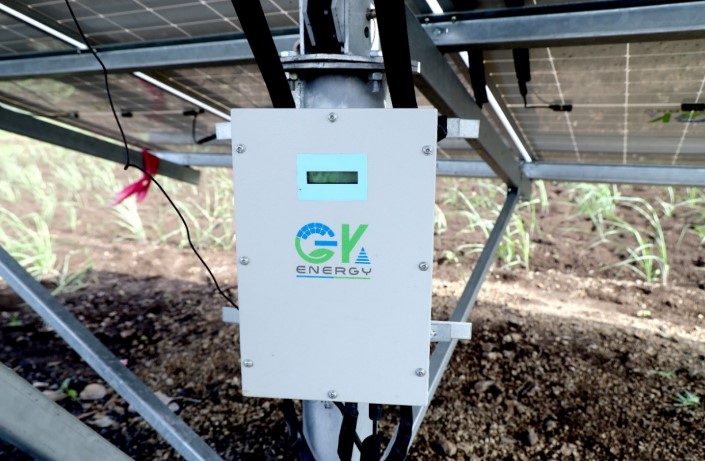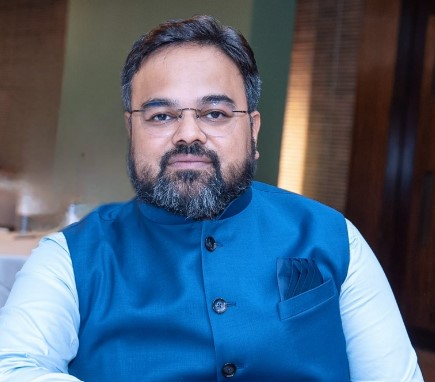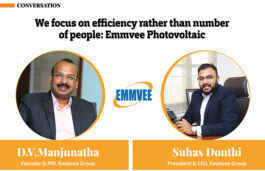

Gopal Kabra, Founder
But before that, how did he end up an entrepreneur?
“I come from a business background and studied commerce in college as well. Even in school, the interest in science was high, and I had even won awards for solar project and in business education first project report was on solar projects. Solar was always on my mind even then. In Marathi, we have a saying Food , shelter and cloth is basic need but I have learnt in my school and college days that – Communication and energy are two add on basic human needs. I decided very early on that I would look to build a business in the latter (energy), preferably a green energy business”, says Kabra.
“After starting off with solar water heaters in 2006, we took on consulting projects for the development of carbon credits for the solar industry where we tied up with manufacturers, spread mainly across Gujarat, Maharashtra and Karnataka. We successfully registered that project along with issuance”.
That was followed by a move into advisory as well, when Kabra worked with the Government of India through the MNRE under a UNDP program when the Jawaharlal Nehru National Solar Mission (JNSSM) was still in the formation phase.
From that start, Kabra was a Secretary of the Solar Thermal Federation of India (STFI). At STFI, he found himself being a key part of the team designing guidelines for building constructions involving solar, he adds.
The Solar Breakthrough
“From 2008 to 2013, at that time, very few megawatt scale power plants came into the picture. We would only consider capacity in Kilowatts (kW). In 2012 we did a remote village electrification RVE project in the Gadchiroli district in Maharashtra, where 1,667 household were electrified by our company. We maintained that project up to 2020. For us, that was our big breakthrough, where we achieved our ambition to deliver decentralised energy at scale”, adds Kabra.
In parallel with the Gadchiroli project, the firm expanded to Chhattisgarh in 2012-13 for a solar project in the forest department under (Chhattisgarh Renewable Energy Development Agency) CREDA . In 2015 GK Energy expanded into Jharkhand as well.
In Jharkhand, GK Energy has been involved with rooftop projects across institutions, including the Court building, district collector offices, jails, hospital , schools this time with JREDA. Interestingly, a number of these projects involved an ( ESS ) energy storage as well.
“We did solar fencing, streetlights, home lights, many things we have done as a whole. But from 2018-19 onwards, our complete focus is on the solar agriculture pump”, Kabra adds. The solar pumps business was more than a present opportunity for Kabra. “The first milestone we achieved in Maharashtra was under the Atal Solar Krushi Pumps Yojana. We have installed approx. 1,200 pumps out of the 8,000 pumps that were installed in that scheme in the state. Then came the Mukhyamantri Solar Krushi Pump Yojana, where GK Energy installed about 4200 pumps in the state under the Yojana.
PMKUSUM Adds Wings
Did the period between 2008-2014, when movement was very slow and solar considered unviable at large scale, ever place doubts in his mind?
Kabra avers that “these challenges are part of every business. But if you are looking to the long term goals then consistency is key, something we have learned from childhood. If you start a business, continue with it. If you are doing it perfectly, you will get the result. So that was the motivation. I’ve seen the module prices fall from Rs 300 to Rs 20 rupees per watt and lower. We learnt a lot during this period, so that by the time we installed 4200 pumps in Maharashtra, we understood the business, and our market very well”.
Which is why when the opportunity of the PM KUSUM scheme arrived, Kabra was ready. He claims that GK Energy is the largest player in Maharashtra in terms of number of pumps installed under PMKUSUM – II, ahead of bigger firms. He credits it to their understanding of the market and focus on service. “If you see , with Atal Solar, we have delivered on our service commitments. The farmer values that, which is why we are a leading player in PMKUSUM as well”.
GK Energy has now expanded into Haryana in 2022 as well in Rajasthan and Uttar Pradesh in PMKUSUM bids.
“We have already installed more than 21,000 pumps in PMKUSUM II (Component B) , and now with PM Kusum III (component B) , we have already secured ~ 30,000 pump from various SNA. That shows the credibility the company has gained into the market. A farmer has the option to select from among all vendors. That we more than hold our ground in such strong competition is a testimony to our work and reputation”, Kabra stresses.
Convince Indian farmers to consider Solar Pumps
“It took almost 10 years to showcase the solar pump, show how it’s performed. We installed our first pump in 2014-2015. The question used to come whether solar pump will work or not, AC, DC, water output, serviceability. We are a very value conscious market, and that only made the whole task more challenging. We saw that farmers have the land, they have the water source, but they were not getting the power supply from the grid. If they are getting it, it is not three phase, because agri pump need the three phase power.
Today we have seen a transition where we have installed the solar pump, and a farmer who was barely able to grow one crop in the year prior to solar pump , can now go for one seasonal crop and two to three cash crops”.
That has been a real life changer, and the best proof of concept for farmers. That’s why the huge demand in the market today. For example, in Maharashtra, 11 lakhs plus applications have been received till PM Kusum three started, and initial allotment was only for about 180,000. That has been moved ahead and it now four lakh allotments have been done in Maharashtra today.
Rewarded With Growth
Kabra informs us that GK Energy grew to Rs 411 crore in revenue from operations in the last financial year. GK Energy has total installed pump base of more than 40,000 as at August 2024. The firm has preferred to outsource manufacturing, while designing the product in-house.
GK Energy, while expanding in other states has taken care to customise offerings for each region. Experience with such a large customer base has also encouraged the firm to go back to the idea of offering rooftop solar solutions. “Solar pumps and the rooftop solar have many similarities and require same infrastructure that is ready with GK energy.
GK Energy has taken care to move with market trends and upgrade technology as well. “Now a DC pump is giving more water output than the AC pump and offers higher efficiency. We have designed a controller that can upgrade the system over the air (online). Most of the service calls we get are handled over the design online customer service support mechanism.
Specially designed products for customer need, robust component and efficient service are the key to success of GK Energy.





























